In the relentless pursuit of efficiency and innovation, modern organizations continuously seek methodologies that not only enhance productivity but also align with their strategic goals. Among the most transformative approaches in recent years is the adoption of Team Topologies—a concept that has revolutionized the way businesses structure their teams for optimal performance. This article delves into the essence of Team Topologies, illustrating its significance and providing a roadmap for its implementation to achieve agile success.
Table of Contents
The Genesis of Team Topologies
Over the past decade, the agile landscape has predominantly navigated between two methodologies: a top-down approach, driven by Portfolio Management Offices (PMOs) aiming to enhance process efficiency and work visibility, and a bottom-up strategy, addressing the immediate needs and challenges faced by teams in execution. This dichotomy, while beneficial in certain aspects, has overlooked two critical components essential for holistic organizational agility: the business perspective and the role of technology leadership.
Historically, agile frameworks have not adequately addressed the business’s intrinsic needs and how these objectives are iteratively realized. The focus has often been on the process rather than on the underlying business value and strategic goals driving these efforts. Equally, technology leaders such as CIOs, CTOs, and their technical competencies have been conspicuously absent from these frameworks. This oversight leaves a gap in aligning technical leadership with agile practices, creating a disconnect between strategy and execution.
Conceived by Matthew Skelton and Manuel Pais, Team Topologies offers a refreshing departure from this trend by prioritizing a more strategic and integrated approach. It begins with a deep understanding of the business’s core needs, transitioning to the architecture that supports these objectives. Only then does it define the team structures necessary to uphold this architecture. This methodology ensures that both the business’s desires and the technology leaders’ expertise are not just considered but are foundational to the agile framework. By doing so, Team Topologies provides a practical and comprehensive model that bridges the gap between business objectives, technical leadership, and team execution.
This approach not only acknowledges but actively incorporates the roles of business stakeholders and technology leaders into the agile process. It shifts the focus from merely executing tasks to understanding and achieving business outcomes, supported by an architecture that enables these goals. In this way, Team Topologies redefines agile integration, offering a pathway to genuine organizational agility that is both inclusive and effective.

The Four Types of Teams
At the heart of this framework are four distinct team types: Stream-aligned teams, Enabling teams, Complicated Subsystem teams, and Platform teams. These teams are designed to operate within a system that emphasizes direct, effective communication and collaboration, ensuring that workflow is not just maintained but optimized.
- Stream-aligned Teams: Dedicated to delivering value through specific work streams, these teams enable swift responses to customer needs and market shifts.
- Enabling Teams: These teams offer expertise and support to Stream-aligned Teams, aiding them in overcoming technical challenges and promoting continuous learning.
- Complicated Subsystem Teams: These teams are experts in handling technically complex systems that demand deep knowledge, providing indirect support to Stream-aligned Teams.
- Platform Teams: They provide services and tools that assist Stream-aligned Teams in executing their tasks with greater efficiency and effectiveness.
Interaction among these teams occurs through three main modes—collaboration, X-as-a-Service, and facilitation—each strategically designed to enhance workflow efficiency and reduce friction.
Strategic Alignment: The Core of Success
The integration of Team Topologies within an organization goes beyond mere team restructuring. It represents a strategic alignment of organizational goals, enterprise architecture (EA), and team structure. This alignment ensures that every aspect of the organization is geared towards achieving its strategic objectives, leveraging technology and team dynamics for competitive advantage.
For instance, if an organization aims to excel in customer experience, its EA should be designed to support rapid deployment and integration of customer feedback. This is where Team Topologies comes into play, enabling the formation of Stream-aligned teams that are agile, customer-focused, and capable of delivering value swiftly.
The graph represents the solid alignment provided by the Team Topologies framework. Business goals break down into the technical architecture definition, which then defines which teams a company should leverage to support the operation.
Benefits of the Team Topologies Framework
- Reduce Cognitive Load: Aligning teams around well-defined, manageable work scopes allows individuals to concentrate more effectively on their duties, reducing the stress of system-wide complexity.
- Optimize for Fast Flow: By refining how teams interact and depend on each other, organizations can accelerate feedback loops and the delivery of value to customers, ensuring a smoother, quicker workflow.
- Enhance Collaboration: With clear interaction modes and defined responsibilities, teams gain a better understanding of when and how to collaborate, creating a supportive environment that encourages both learning and ongoing improvement.
Practical Applications: From Theory to Action
The theoretical framework of Team Topologies finds practical application across various industries, demonstrating its versatility and effectiveness.
- Financial Institutions: In the context of banking and finance, adopting Team Topologies can significantly enhance customer experience and operational efficiency. By aligning EA around microservices and APIs, financial institutions can create Stream-aligned teams that are empowered to innovate rapidly, with Platform teams providing the necessary tools and Enabling teams offering deep technical expertise.
- Retail Sector: Retail companies seeking operational efficiency can benefit from integrating their systems into a unified ERP platform. Here, Platform teams manage the infrastructure, enabling Stream-aligned teams to optimize operations across different segments, from inventory management to customer service.
- Healthcare Organizations: Prioritizing data security and compliance, healthcare organizations can adopt secure data architectures and organize teams around managing patient data securely. Platform and Enabling teams support these efforts by providing the necessary tools and expertise to maintain high standards of security and compliance.
Implementing Team Topologies: A Step-by-Step Guide
Adopting Team Topologies involves a strategic and methodical approach, starting with an assessment of the current organizational structure and identifying areas for improvement. This process includes defining clear organizational goals, educating leadership and teams about the Team Topologies framework, and experimenting with new team structures.
- Assessment: Begin by evaluating the current state of your organization’s team structure, workflows, and delivery processes. Identify bottlenecks, inefficiencies, and opportunities for improvement.
- Goal Setting: Align the implementation of Team Topologies with your organization’s strategic objectives. Whether it’s enhancing customer satisfaction, improving time-to-market, or increasing operational efficiency, ensure that your goals are clear and measurable.
- Education and Engagement: Host workshops and training sessions to familiarize leadership and team members with the Team Topologies concepts. Emphasize the benefits and the changes that will ensue, fostering a culture of openness and adaptability.
- Experimentation: Design and trial new team configurations based on the Team Topologies framework. Start with pilot areas where quick wins are achievable, and iteratively refine your approach based on feedback.
- Implementation: Define clear interaction modes between teams, including Collaboration, X-as-a-Service, and Facilitating. Establish service-level agreements (SLAs) for internal services to ensure that they meet the consuming teams’ needs.
- Continuous Improvement: Encourage feedback and learning from the initial implementations. Use retrospectives and feedback loops to refine team structures and workflows, promoting a culture of experimentation and innovation.
- Scaling and Institutionalization: Gradually expand the implementation across the organization, leveraging insights and successes from pilot areas to guide the rollout. Update policies, processes, and tooling to support the new team structures and interaction modes.
- Ensure Compliance and Security: Embed compliance and security practices into teams, especially Stream-aligned and Platform teams. Enabling teams should help maintain these standards, ensuring seamless integration into daily operations without disrupting efficiency.
A strategic move towards Team Topologies
The adoption of Team Topologies is not merely a trend but a strategic move towards organizational agility, efficiency, and enhanced value delivery. By creating a structure that fosters clear communication, collaboration, and alignment with strategic goals, organizations can unlock their full potential. Through careful planning, adaptability, and a commitment to continuous improvement, the principles of Team Topologies can guide any organization towards achieving not just operational excellence but a significant competitive edge in today’s dynamic business landscape.







